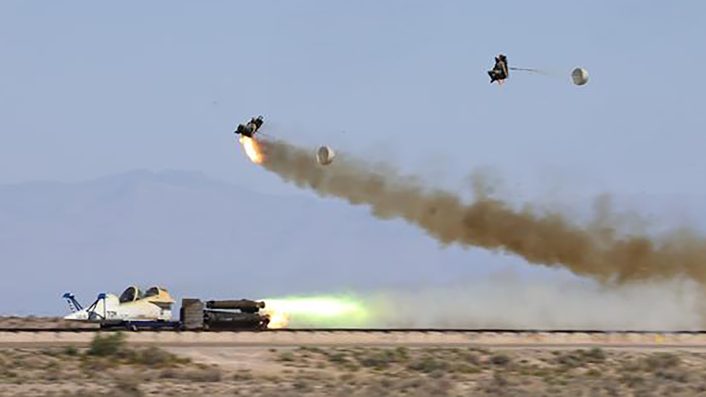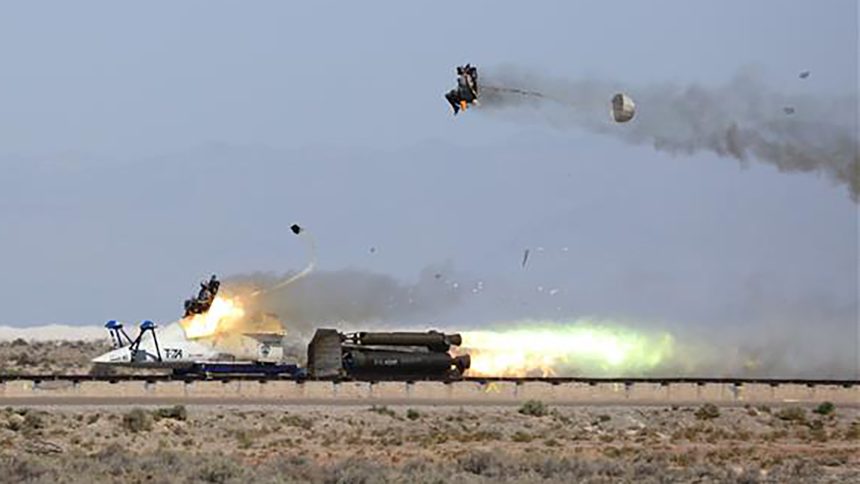The new T-7A Red Hawk ejection system passes high-speed test at Holloman Air Force Base, New Mexico.
After coming under scrutiny for serious ejection system deficiencies identified during earlier testing, the T-7A Red Hawk advanced trainer has cleared a key developmental hurdle, with the U.S. Air Force announcing the successful completion of a high-speed ejection test.
The test, conducted by the 846th Test Squadron at Holloman Air Force Base on Apr. 16, 2025, simulated a 450-knot ejection and met all test objectives. It marks a significant step forward for the program, particularly following a string of delays and safety concerns raised in the Pentagon’s most recent Director of Operational Test and Evaluation (DOT&E) report, released in January.
The system’s performance during this latest round of testing demonstrated the ability to protect both lighter and heavier pilot profiles, using test mannequins to simulate real-world ejections. Two major upgrades were under evaluation: a redesigned canopy jettison system and an improved ejection seat sequencer.
The redesigned canopy is intended to shatter in a more controlled pattern, reducing the risk of injury from canopy fragments. Meanwhile, the updated sequencer now allows for a longer drogue chute deployment to stabilize the seat earlier in the trajectory—critical for minimizing neck and spinal injuries during high-speed bailouts.
This test follows a difficult period for the T-7A program. The DOT&E’s FY2024 report, released earlier this year, revealed that environmental and safety testing had uncovered “serious and potentially dangerous deficiencies” in the ejection system. Those issues contributed to a cascade of delays that pushed back the aircraft’s Initial Operational Capability (IOC) from 2024 to at least 2027.
The Air Force and Boeing have since been working to address those deficiencies. The high-speed sled test appears to show that some of those fixes are beginning to pay off.
Originally conceived to replace the T-38 Talon, the T-7A Red Hawk features a digital design and open architecture aimed at making it adaptable for future pilot training needs, especially for fifth-generation fighter aircraft. But its ejection system—originally intended to accommodate a wider range of pilot sizes and weights—has been a persistent engineering and certification challenge.
Another test of the escape system is scheduled for August, as the Air Force continues efforts to fully qualify the Red Hawk for operational use by student and instructor pilots.
While one successful test won’t erase the technical hurdles the program still faces, it’s a crucial data point as the T-7A works to regain lost ground and deliver the next-generation training capability the Air Force has been counting on.

T-7A Red Hawk
The T-7A Red Hawk program, developed by Boeing in partnership with Saab, represents a significant advancement in the U.S. Air Force’s pilot training capabilities. Designed to replace the aging T-38 Talon, the T-7A incorporates modern technologies to prepare pilots for fifth-generation aircraft operations.
Key Developments:
- Program Inception and Naming: In September 2018, the U.S. Air Force awarded Boeing a $9.2 billion contract for the T-7A program, aiming to procure 351 aircraft by 2034. The aircraft was officially named “Red Hawk” in September 2019, honoring the Tuskegee Airmen and their red-tailed aircraft from World War II.
- Design and Production: The T-7A was developed using digital engineering, allowing for rapid prototyping and testing. This approach enabled the first flight of the production variant within 36 months of the initial design.
- Testing Milestones: The first T-7A Red Hawk arrived at Edwards Air Force Base in November 2023, marking the commencement of developmental flight testing. This phase aims to validate the aircraft’s performance and suitability for training missions.
- Operational Delays: Initially slated for service entry in 2023-2024, the T-7A’s Initial Operational Capability (IOC) has been postponed to 2027 due to issues such as ejection seat safety concerns and software development challenges.









